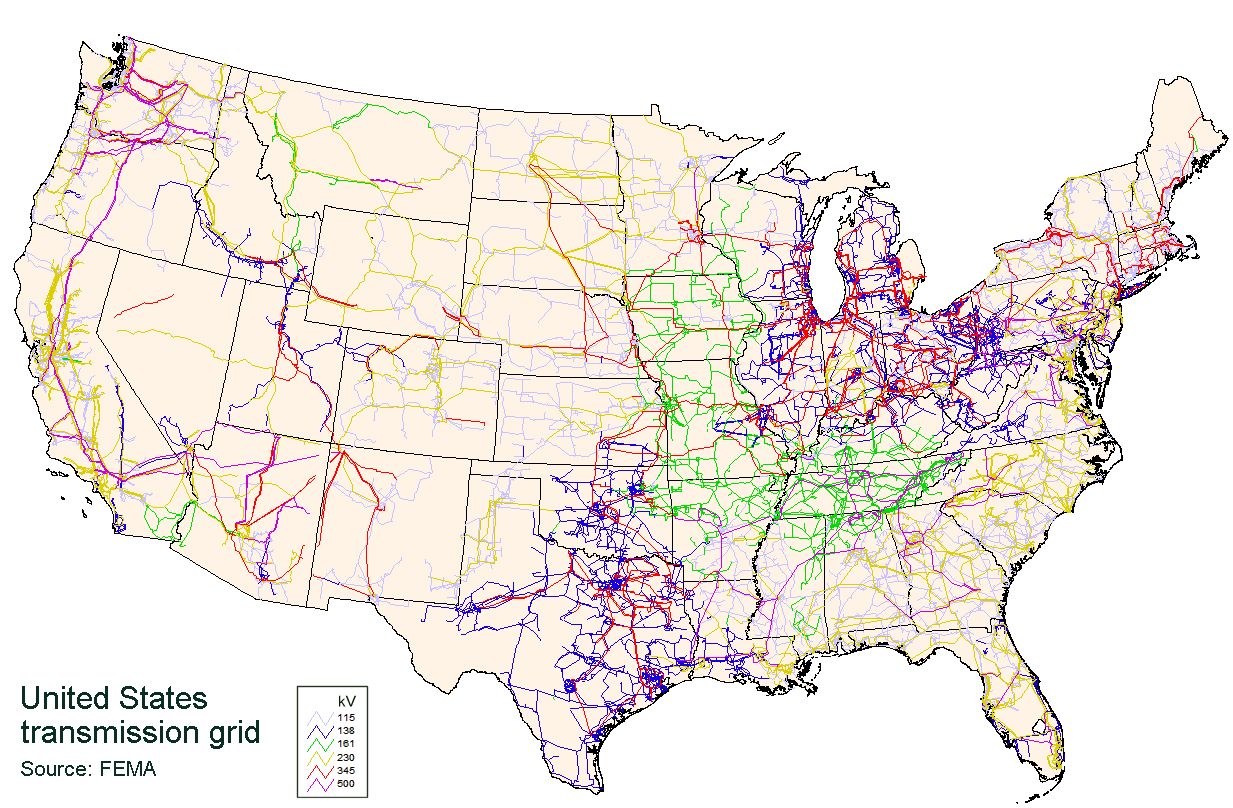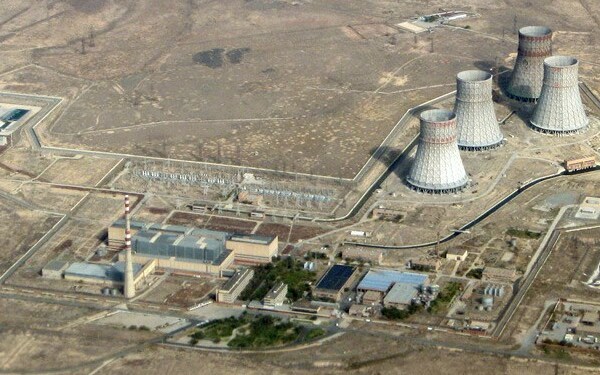|
Droop Speed Control
Droop speed control is a control mode used for AC electrical power generators, whereby the power output of a generator reduces as the line frequency increases. It is commonly used as the speed control mode of the governor of a prime mover driving a synchronous generator connected to an electrical grid. It works by controlling the rate of power produced by the prime mover according to the grid frequency. With droop speed control, when the grid is operating at maximum operating frequency, the prime mover's power is reduced to zero, and when the grid is at minimum operating frequency, the power is set to 100%, and intermediate values at other operating frequencies. This mode allows synchronous generators to run in parallel, so that loads are shared among generators with the same droop curve in proportion to their power rating. In practice, the droop curves that are used by generators on large electrical grids are not necessarily linear or the same, and may be adjusted by operators. ... [...More Info...] [...Related Items...] OR: [Wikipedia] [Google] [Baidu] |
Governor (device)
A governor, or speed limiter or controller, is a device used to measure and regulate the speed of a machine, such as an engine. A classic example is the centrifugal governor, also known as the Watt or fly-ball governor on a reciprocating steam engine, which uses the effect of inertial force on rotating weights driven by the machine output shaft to regulate its speed by altering the input flow of steam. History Centrifugal governors were used to regulate the distance and pressure between millstones in windmills since the 17th century. Early steam engines employed a purely reciprocating motion, and were used for pumping water – an application that could tolerate variations in the working speed. It was not until the Scottish engineer James Watt introduced the ''rotative'' steam engine, for driving factory machinery, that a constant operating speed became necessary. Between the years 1775 and 1800, Watt, in partnership with industrialist Matthew Boulton, produced so ... [...More Info...] [...Related Items...] OR: [Wikipedia] [Google] [Baidu] |
Power Station
A power station, also referred to as a power plant and sometimes generating station or generating plant, is an industrial facility for the electricity generation, generation of electric power. Power stations are generally connected to an electrical grid. Many power stations contain one or more Electric generator, generators, rotating machine that converts mechanical power into three-phase electric power. The relative motion between a magnetic field and a Electrical conductor, conductor creates an electric current. The energy source harnessed to turn the generator varies widely. Most power stations in the world burn fossil fuels such as coal, petroleum, oil, and natural gas to generate electricity. Low-carbon power sources include nuclear power, and use of renewable energy, renewables such as solar power, solar, wind power, wind, geothermal power, geothermal, and hydroelectricity, hydroelectric. History In early 1871 Belgian inventor Zénobe Gramme invented a generator powerfu ... [...More Info...] [...Related Items...] OR: [Wikipedia] [Google] [Baidu] |
Synchronous Generator
An alternator (or synchronous generator) is an electrical generator that converts mechanical energy to electrical energy in the form of alternating current. For reasons of cost and simplicity, most alternators use a rotating magnetic field with a stationary armature.Gordon R. Selmon, ''Magnetoelectric Devices'', John Wiley and Sons, 1966 no ISBN pp. 391-393 Occasionally, a linear alternator or a rotating armature with a stationary magnetic field is used. In principle, any AC electrical generator can be called an alternator, but usually, the term refers to small rotating machines driven by automotive and other internal combustion engines. An alternator that uses a permanent magnet for its magnetic field is called a magneto. Alternators in power stations driven by steam turbines are called turbo-alternators. Large 50 or 60 Hz three-phase alternators in power plants generate most of the world's electric power, which is distributed by electric power grids. History Altern ... [...More Info...] [...Related Items...] OR: [Wikipedia] [Google] [Baidu] |
Electrical Grid
An electrical grid (or electricity network) is an interconnected network for electricity delivery from producers to consumers. Electrical grids consist of power stations, electrical substations to step voltage up or down, electric power transmission to carry power over long distances, and finally electric power distribution to customers. In that last step, voltage is stepped down again to the required service voltage. Power stations are typically built close to energy sources and far from densely populated areas. Electrical grids vary in size and can cover whole countries or continents. From small to large there are microgrids, wide area synchronous grids, and super grids. The combined transmission and distribution network is part of electricity delivery, known as the ''power grid''. Grids are nearly always synchronous, meaning all distribution areas operate with three phase alternating current (AC) frequencies synchronized (so that voltage swings occur at almost the same ... [...More Info...] [...Related Items...] OR: [Wikipedia] [Google] [Baidu] |
Base Load
The base load (also baseload) is the minimum level of demand on an electrical grid over a span of time, for example, one week. This demand can be met by unvarying power plants or dispatchable generation, depending on which approach has the best mix of cost, availability and reliability in any particular market. The remainder of demand, varying throughout a day, is met by intermittent sources together with dispatchable generation (such as load following power plants, peaking power plants, which can be turned up or down quickly) or energy storage. Power plants that do not change their power output quickly, such as some large coal or nuclear plants, are generally called baseload power plants.Donald G. Fink, H. Wayne Beatty (ed), ''Standard Handbook for Electrical Engineers'', Eleventh Edition, Mc-Graw Hill, 1978 , pp. 12-16 through 12-18 In the 20th century most or all of base load demand was met with baseload power plants, whereas new capacity based around renewables often employs ... [...More Info...] [...Related Items...] OR: [Wikipedia] [Google] [Baidu] |
Inertia
Inertia is the natural tendency of objects in motion to stay in motion and objects at rest to stay at rest, unless a force causes the velocity to change. It is one of the fundamental principles in classical physics, and described by Isaac Newton in his Newton%27s_laws_of_motion#First, first law of motion (also known as The Principle of Inertia). It is one of the primary manifestations of mass, one of the core quantitative properties of physical systems. Newton writes: In his 1687 work ''Philosophiæ Naturalis Principia Mathematica'', Newton defined inertia as a property: History and development Early understanding of inertial motion Joseph NeedhamProfessor John H. Lienhard points out the Mozi (book), Mozi – based on a Chinese text from the Warring States period (475–221 BCE) – as having given the first description of inertia. Before the European Renaissance, the prevailing theory of motion in western philosophy was that of Aristotle (384–322 BCE). On the surface ... [...More Info...] [...Related Items...] OR: [Wikipedia] [Google] [Baidu] |
Centrifugal Governor
A centrifugal governor is a specific type of governor with a feedback system that controls the speed of an engine by regulating the flow of fuel or working fluid, so as to maintain a near-constant speed. It uses the principle of proportional control. Centrifugal governors, also known as "centrifugal regulators" and "fly-ball governors", were invented by Christiaan Huygens and used to regulate the distance and pressure between millstones in windmills in the 17th century. In 1788, James Watt adapted one to control his steam engine where it regulates the admission of steam into the cylinder(s), a development that proved so important he is sometimes called the inventor. Centrifugal governors' widest use was on steam engines during the Steam Age in the 19th century. They are also found on stationary internal combustion engines and variously fueled turbines, and in some modern striking clocks. A simple governor does not maintain an exact speed but a speed range, since under increa ... [...More Info...] [...Related Items...] OR: [Wikipedia] [Google] [Baidu] |
Engine Control Unit
An engine control unit (ECU), also called an engine control module (ECM), is a device that controls various subsystems of an internal combustion engine. Systems commonly controlled by an ECU include the fuel injection and ignition systems. The earliest ECUs (used by aircraft engines in the late 1930s) were mechanical-hydraulic units; however, most 21st-century ECUs operate using digital electronics. Functions The main functions of the ECU are typically: * Fuel injection system * Ignition system * Idle speed control (typically either via an idle air control valve or the electronic throttle system) * Variable valve timing and/or variable valve lift systems The sensors used by the ECU include: * accelerator pedal position sensor * camshaft position sensor * coolant temperature sensor * crankshaft position sensor * knock sensors * inlet manifold pressure sensor ( MAP sensor) * intake air temperature * intake air mass flow rate sensor ( MAF sensor) * oxygen (lambda) s ... [...More Info...] [...Related Items...] OR: [Wikipedia] [Google] [Baidu] |
Electric Power Transmission
Electric power transmission is the bulk movement of electrical energy from a generating site, such as a power plant, to an electrical substation. The interconnected lines that facilitate this movement form a ''transmission network''. This is distinct from the local wiring between high-voltage substations and customers, which is typically referred to as electric power distribution. The combined transmission and distribution network is part of electricity delivery, known as the electrical grid. Efficient long-distance transmission of electric power requires high voltages. This reduces the losses produced by strong currents. Transmission lines use either alternating current (AC) or direct current (DC). The voltage level is changed with transformers. The voltage is stepped up for transmission, then reduced for local distribution. A wide area synchronous grid, known as an ''interconnection'' in North America, directly connects generators delivering AC power with the same rela ... [...More Info...] [...Related Items...] OR: [Wikipedia] [Google] [Baidu] |
Wide Area Synchronous Grid
A wide area synchronous grid (also called an "interconnection" in North America) is a three-phase electric power grid that has regional scale or greater that operates at a synchronized utility frequency and is electrically tied together during normal system conditions. Also known as ''synchronous zones'', the most powerful is the Northern Chinese State Grid with 1,700 gigawatts (GW) of generation capacity, while the widest region served is that of the IPS/UPS system serving most countries of the former Soviet Union. Synchronous grids with ample capacity facilitate electricity trading across wide areas. In the CESA system in 2008, over 350,000 megawatt hours were sold per day on the European Energy Exchange (EEX). Neighbouring interconnections with the same frequency and standards can be synchronized and directly connected to form a larger interconnection, or they may share power without synchronization via high-voltage direct current power transmission lines (DC ties), so ... [...More Info...] [...Related Items...] OR: [Wikipedia] [Google] [Baidu] |
Dynamic Demand (electric Power)
Dynamic Demand is the name of a semi-passive technology to support demand response by adjusting the load demand on an electrical power grid. It is also the name of an independent not-for-profit organization in the UK supported by a charitable grant from the Esmée Fairbairn Foundation, dedicated to promoting this technology. The concept is that by monitoring the frequency of the power grid, as well as their own controls, intermittent domestic and industrial loads switch themselves on/off at optimal moments to balance the overall grid load with generation, reducing critical power mismatches. As this switching would only advance or delay the appliance operating cycle by a few seconds, it would be unnoticeable to the end user. This is the foundation of dynamic demand control. In the United States, in 1982, a (now-lapsed) patent for this idea was issued to power systems engineer Fred Schweppe. Other patents have been issued based on this idea. Dynamic demand is similar to demand re ... [...More Info...] [...Related Items...] OR: [Wikipedia] [Google] [Baidu] |







